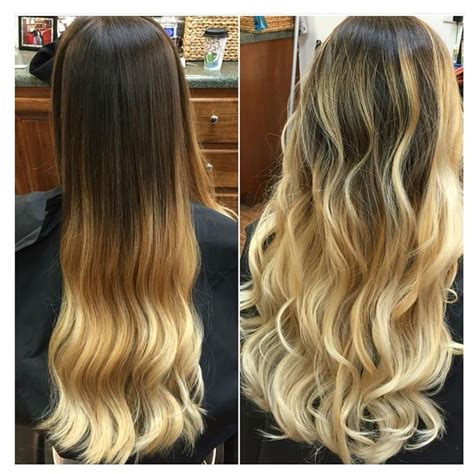In a hair world teeming with captivating color techniques, balayage and ombre reign supreme. While these transformative processes share similarities in their ability to illuminate locks with breathtaking hues, they stand apart in distinct ways. This comprehensive guide delves into the intricacies of balayage and ombre, empowering you to make an informed decision on which technique best suits your vision.

Balayage: The Art of Freehand Painting
Balayage, derived from the French word “to sweep,” is an art form in which hair color is meticulously hand-painted onto sections of the hair. Skilled stylists employ a technique akin to freehand painting, allowing them to create natural-looking, sun-kissed highlights that blend seamlessly with the natural hair color.
Benefits of Balayage:
- Low-maintenance: Balayage requires minimal touch-ups, with appointments spaced out 6-12 months apart.
- Personalized: The freehand application allows stylists to tailor the highlights to each individual’s features and preferences.
- Youthful appearance: Balayage subtly brightens the face, creating a youthful glow.
Drawbacks of Balayage:
- Time-consuming: The hand-painting process can take several hours to complete.
- Skill-dependent: The outcome of balayage heavily relies on the stylist’s experience and artistic ability.
- Costly: Due to the intricate nature of the technique, balayage appointments can be more expensive than other coloring methods.
Ombre: The Gradual Fade From Dark to Light
Ombre, meaning “shaded” in French, is a gradual transition from darker roots to lighter ends. Unlike balayage, which focuses on highlights, ombre creates a seamless blend between two or more shades. The result is a bold yet sophisticated look that mimics the sun-bleached hair often seen after a summer spent outdoors.
Benefits of Ombre:
- Dramatic effect: Ombre’s striking contrast between dark and light makes a statement that turns heads.
- Versatile: Ombre can be customized to suit various hair lengths, textures, and skin tones.
- Budget-friendly: Compared to balayage, ombre is typically less expensive due to the shorter application time.
Drawbacks of Ombre:
- Higher maintenance: Ombre requires more frequent touch-ups (every 8-12 weeks) to maintain the gradient effect.
- Harsh line of demarcation: In some cases, a visible line can appear where the darker and lighter shades meet.
- Not suitable for all: Ombre may not be ideal for those with very short or fine hair.
Balayage vs Ombre: A Comparative Guide
| Feature | Balayage | Ombre |
|---|---|---|
| Application Method | Freehand painting | Gradual blending |
| Highlight Placement | Targeted sections | Seamless transition |
| Maintenance | Low-maintenance (6-12 months) | Higher-maintenance (8-12 weeks) |
| Effect | Sun-kissed highlights | Dramatic contrast |
| Cost | More expensive | Less expensive |
| Suitability | All hair lengths and textures | Better for medium to long hair |
Conclusion
Both balayage and ombre offer unique advantages and disadvantages. The best choice for you depends on your desired effect, hair type, and budget.
For a natural, low-maintenance look that mimics the sun’s touch, balayage is an excellent option. If you crave a bold, statement-making style that requires more upkeep, ombre is a stunning choice.
Remember, the key to a successful balayage or ombre experience lies in finding a skilled and experienced stylist. With their expertise, you can achieve the luminous, head-turning hair you’ve always desired.
Frequently Asked Questions
Which technique is better for my hair type?
- Balayage is generally more suitable for all hair types, including fine and thin hair.
- Ombre is best for medium to long hair, as shorter hair may not show the gradient effect as well.
How long does balayage or ombre last?
- Balayage can last 6-12 months with proper care.
- Ombre requires more frequent touch-ups, usually every 8-12 weeks.
Can I do balayage or ombre at home?
- Attempting balayage or ombre at home is not recommended, as it requires specialized skills and techniques. A reputable salon and stylist are always the safest choices.
Future Innovations in Balayage and Ombre
The world of hair color is constantly evolving, with new techniques and technologies emerging. Here are some innovative applications and ideas:
- Reverse balayage: Creating darker highlights on lighter hair to achieve a shadow root effect.
- Blending balayage: Combining balayage with other techniques, such as babylights or foiling, to create a multidimensional look.
- Ombre with hidden roots: Maintaining darker roots while blending into lighter shades, creating a subtle and sophisticated contrast.
- Thermally activated ombre: Using heat to activate specific hair dyes, creating ombré effects that shift in hue depending on temperature.
